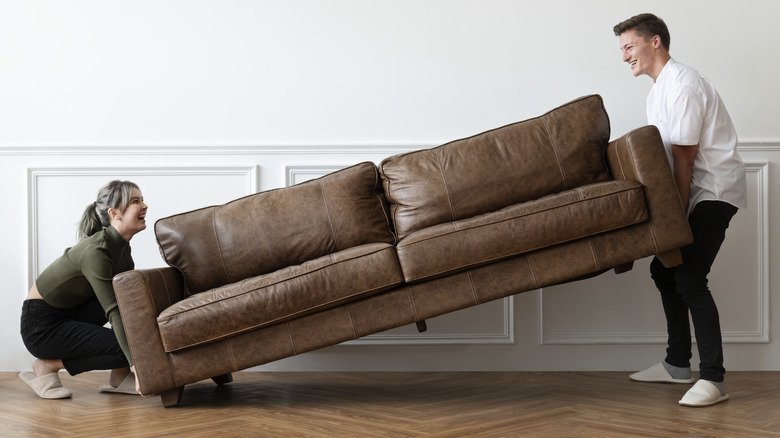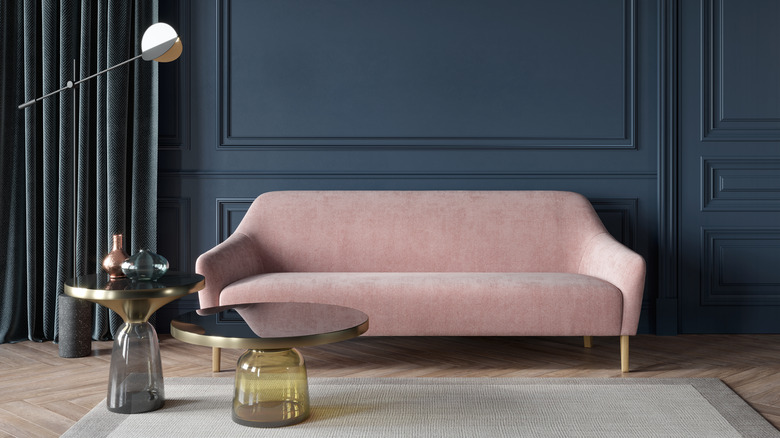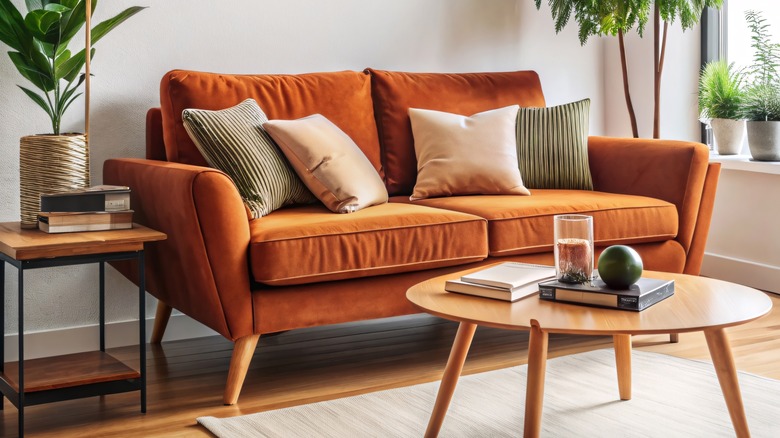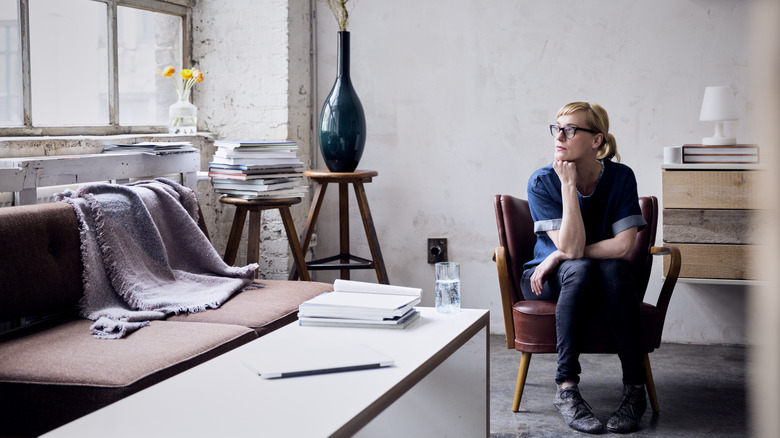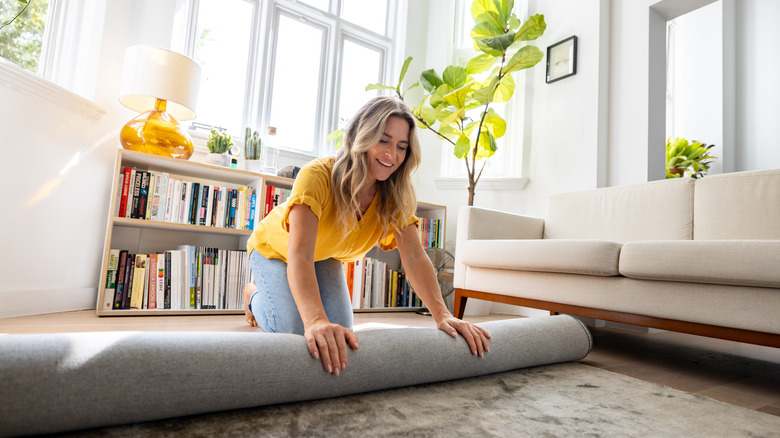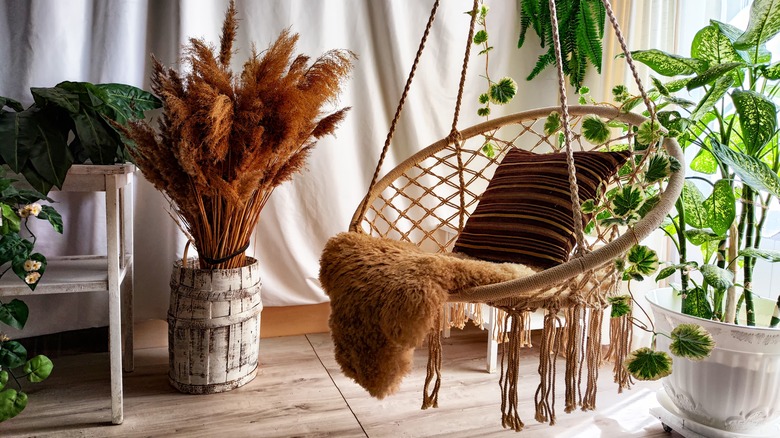Tips & Tricks To Make A Sofa Work Seamlessly In A Small Living Room
The market for small homes is booming. They're popular with people from all walks of life, from first-time buyers who can't afford a large property to downsizers who don't want to maintain one. Whether you live in a tiny home or you just have a quirky floor plan, arranging furniture can be one of the biggest home decor challenges. Cramped spaces are especially awkward during the holiday season, when we're more likely to have guests looking for somewhere comfortable to sit and visit or watch the game. Offering cozy seating options is one of the easiest ways to make your house more welcoming. But how do you make a sofa work seamlessly in a small living room?
According to Home News Now, its Consumer Insights Now research found that regardless of age or budget, most people spend the majority of their time in the living room and bedroom. It makes sense, then, that the Provoke Insights Summer 2024 survey (conducted in conjunction with Furniture Today) found that sofas and mattresses are among the top five categories on most furniture shopping lists. If you're in the market for a new couch, there are some important tips and tricks to keep in mind.
A simple loveseat or smaller silhouette work better than an overstuffed sofa
Certain sofa styles work better in small living rooms than others. Selecting a smaller silhouette is just one way you can create a more spacious feel in your living room. In fact, you may want to consider a loveseat instead of a sofa. Unsure of the difference? Both can be designed to seat two people, but a loveseat is usually narrower from arm to arm. You can also create the illusion of more space by choosing a tailored sofa or loveseat with slender fluted legs or claw foot designs instead of blocky feet or slipcovers. Along with foregoing skirted models, avoid overstuffed and sectional options, especially those with loose cushions.
There are many unique sofas that are perfect for a small space. Always opt for clean lines when you don't have much room, because too many pleats or ruffles can easily take over an area. The same goes for color and pattern. There's nothing wrong with picking a soft boucle or other textured fabric in a brilliant hue, but busy patterns can make a room feel smaller. If you have your heart set on a print, opt for a larger pattern or three-dimensional design, both of which can create a sense of depth.
Focus on sofa proportion and placement
Traffic flow is one of the most important elements of any successful space, so pay particular attention to where you set your sofa in a small living room. It's best to position it against a wall or in a corner instead of floating it in the middle of an area where it may block natural walkways. Consider the other features of your living room. Is there a large window, fireplace, or entertainment center? If so, place your sofa opposite these features to create a sense of balance.
Although it presents some unique challenges, a small space also provides an opportunity to play with proportion and shape. If you have a long or narrow living room, create contrast with a curved sofa. For small spaces with high ceilings, draw the eye up by choosing a loveseat with a higher back. When it's not possible to keep an open flow of traffic or you want to lounge in very close quarters, an armless sofa can be a great solution.
Choose the right accent furniture
Not having enough seating is one of the most common mistakes people make when designing their living room. If you have a larger family or like to host big gatherings in a small space, you need to carefully consider accent furniture in addition to selecting the right sofa. Instead of a sprawling sectional, try a loveseat and accent chairs instead. If you know you'll occasionally need more seating than you normally do in your day-to-day life, add stools to your space that can double as side tables.
Rather than using a solid coffee table, choose a modern design or stacking model with glass tops that can stand up to wear and tear without visibly crowding your space. Metallic drink tables also work well in small living rooms by reflecting light around the room. To avoid bulky entertainment centers or stands, mount your television on the wall — or even recess your TV to create even more space. Storing your media devices on floating shelves instead of in heavy cabinets will also create the illusion of more area.
Use accessories to make your small living room seem larger
When space is limited, it's important to keep clutter to a minimum. Rooms without personal accessories can feel cold and sterile, but be very selective about what you add to your small living quarters. If you decide to add an area rug, make sure it's the right size — it should be at least 6 inches wider than your sofa on each end.
Wall art is another accessory where bigger is better when you're decorating in limited space. Several framed pieces or a gallery wall can make a small room feel claustrophobic. Hang a limited number of frameless large-scale artworks instead. You should also hang your curtains as high as possible to draw the eye up and make a room feel bigger.
Ample lighting also helps to foster a sense of spaciousness. A floor-length mirror can brighten a dark corner without taking up much room. If your living area doesn't get much natural light, bring the outside in with indoor plants that will thrive in a small space. Instead of taking up valuable floor real estate, hang plants from the ceiling or place them on floating shelves.
Ditch the sofa entirely
Maybe you simply can't fit a sofa through the front door or find someone to help you carry it up a flight of stairs. Perhaps no matter where you position it, the flow of traffic won't work for your family. Or maybe a new couch just isn't in your budget right now. There are certain situations where a sofa may be the wrong choice no matter its style, material, or placement. In those cases, be open-minded when it comes to furniture alternatives for your small living room.
If you live alone and just want to lounge around and watch TV, think about a chaise lounge or recliner. When your living room doubles as a playroom, use bean bag chairs, soft stools, or colorful floor cushions. Consider incorporating multi-functional furniture, like a futon or modular seating. Plastic stackable chairs, a vintage wooden chest with storage, a macrame swing chair carefully hung from the ceiling ... With a little creativity, you can ditch the sofa entirely.
